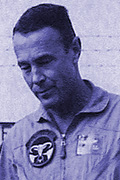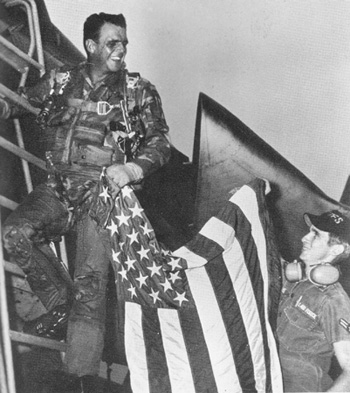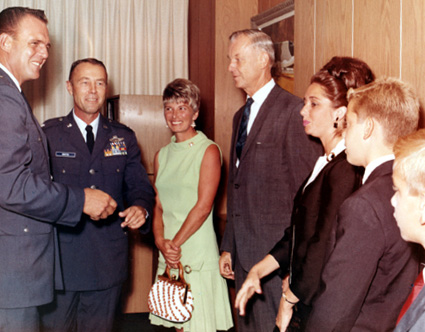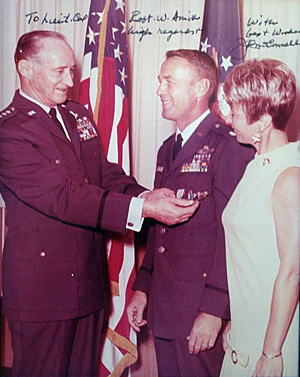Chapter 5 >
Autobiography home >
NF-104 home

|
|
|
Chapter 2 Aerial Combat |
|
Chapter 3 Flight Test |
| Chapter
4 Approach to Space |
|
Chapter 5 Limited Weapons, Assured Defeat! |
|
Chapter 6 Limited War: Unlimited Sacrifices & Defeat t/c |
|
Chapter 7 End of the Beginning t/c |
|
Chapter 5 - Limited Weapons, Assured Defeat click on the links below for more of the story... i. Limited Feedback - ii. Back to School - iii. 388 Tactical Fighter Wing - iv. Rolling Thunder - v. Rules by Fools - vi. The Bridge - vii. Good Morning Vietnam! - viii. Home Again |
||||||
Home AgainH.Q, U.S.A.F., Pentagon, Washington, D.C. June – August 1969 I was back once more to the city where I was born, but never wished to be, working in the Pentagon and assigned to DCS Procurement on the F-111 swept-wing fighter program. That project was prominent in a childish game between the Air Force and the Senate Armed Services Committee, whose powerful leader, Sen. McClellan was determined to prove the F-111 could barely fly, while the Pentagon under dominant civilian decision makers installed by recently departed Secretary of Defense, Mc Namara, set out to respond that it could almost fly with the engines shut-off. Extensive and costly paper evaluations passed back and forth, serving no real purpose. It was nothing like the Air Force that I had joined 20 years before, and which became increasingly political from without, and moving to within. Many things added up, not the least of which was my performance appraisals in flight test and Vietnam combat, but one thing that happened put the cap on everything. An Army 2nd Lieutenant’s hand written note to the Air Force Deputy Chief of Staff for Operations was the final straw. “Tactical Air Power has never been effective in war!” he declared. Was the lieutenant punished? Not on your life! Instead a major effort was directed and scores of high-ranking people in the Air Staff were dedicated to the task of responding with pages of historically based rebuttal. Studies were done on the accomplishments of tactical airpower during WW II, Korea and Vietnam. This with a war in progress! That reaction was because the second lieutenant was a PhD in the Analysis Group of Secretary of Defense, McNamara, as the tactical air “Whiz Kid”. The situation deteriorated for a long time, then improved greatly under President Reagan’s administration, but deteriorated greatly with President Clinton administration, at which point politics again permeated the top echelons. That was demonstrated by the request for early retirement in his own and honorable way of protest by Air Force Chief of Staff, General Ronald Fogleman. Jim Bean, 388th Deputy for Operations had initiated award of the Air Force Cross to me, before he was shot down. Bob Ronca, my buddy and comrade from the 335th squadron - when we flew combat in Korea and for two years flying tests at Eglin, had received an AFC, posthumously presented for continuing to attack a ground target in Pack I after being hit in his F-100. His award was far more deserved, so I will always consider mine shared with many deserving members of our 34th squadron.
Since the presentation was in the Pentagon, by the Chief of Staff, all of the A.F. Deputy Chief’s attended and lined up for congratulating. My Dad lived in D.C., with his wife, a dear friend for many years, and my youngest two half-brothers. One of my favorite photos shows the six of us with recently promoted B/G John C. Giraudo. That was a very special first and only meeting with this hero and great combat leader, who was an idol, not only of his 355th pilots, but all of us.
I had little time to wear my Vietnam awards because of a chosen or forced career move, depending on point of view, retirement. I did so with mixed emotions, whereas Martha’s were enamored of Air Force life, but she adapted perfectly, as I expected she would, because it’s her nature to make life good. As a representative of many Thud Jocks, I was deserving of being honored and recognized. As an individual I am glad to have been considered in that recognition for the difficult job under trying political restraints and without popular support that we were duty bound to accomplish.
I was honored to have the Air Force Cross, Silver Star and my 4th Distinguished Flying Cross, products of my two combat tours awarded to me and pinned on by Air Force Chief of Staff, General McConnell, so near the end of the favorite time of my life. And with the honor of having a number of the Deputy Chiefs in attendance. There was little time before retirement and no time to wear medals after that, so mine have their place in my office at home, a place where photos and mementos recall for me the finest people and most exciting events of my life. Medals are awarded to individuals but seldom earned along and the higher the level of those medals the more warriors shared directly in them. The Air Force Cross and Silver Star, if not my other awards, were absolutely attributable directly to the courage and performance under fire of my Vietnam mates in the sky and made possible by the ground crews that kept us going.
Rewards come easier to commanders because they are recognitions of the effectiveness of the unit and when I view them my mind drifts to many people in the 34th Squadron who gave so much of themselves. That was true with my first Distinguished Flying Cross, which rewarded a lieutenant for shooting down MiG-15’s, because he could trust another lieutenant wingman to protect him. It was equally true of the Air Force Cross because 19 other F-105 pilots risked equally the hazards on every mission. Many paid the highest sacrifice, and others suffered unimaginably as prisoners of very cruel captors. They were the real heroes! The military had things going the way they should in Desert Storm. The same armies we now fight in Iraq were totally at our mercy, cornered for the kill, until President George W. H. Bush halted the attack, when at that time Chairman of the Joint Chiefs Gen. Colin Powell was little more than a pawn in that. The enemy walked out of a deadly trap to survive and fight again. Desert Storm, Phase Two, so quickly effective could be a repeat episode unless a democratic Iraq emerges, a real long shot and dangerous work for our comrades on the ground. Powell now plays a pivotal role as Secretary of State, along with SecDef in the outcome. It will prove to be either the greatest drain on America and accelerator of our decline as a nation or the beginning of a new period of world security and peace. The one common thread that has made us successful, beyond our economic capacity and technology is the strength and determination, the loyalty and integrity of American fighting forces when the call goes out. I have seen it close up and personal twice. Recently, as the troops entered and captured Saddam Hussein Airport and renamed it Baghdad International, I was proud beyond description. Their difficult and dangerous task of policing is no less a combat tour. Let’s hope our leading politicians and statesmen do as well with their part to assure success!
Yes Martha, There Is Life After Air Force My 23 years in Aerospace industry proved a great surprise. When I left the world I treasured and only one I knew, I left with disenchantment, but had great reservations about any real satisfying experience in the future, because, except for his character, accomplishment is what defines a man. And satisfaction in the accomplishment is what makes it a good choice. I made special effort never to compare it with my former career, expecting that I would have to measure my goals and accomplishments against different sorts of standards to find satisfaction. I discovered in flying that what satisfied me most in life’s work was to succeed in challenges when the probability of failure was highest, and its risks greatest. Not a “death wish” as some people suppose, but the determination to overcome tough odds in that work. When I moved to industry, I found that same challenge by searching out jobs where direct measurement of performance was exact and demanding. There are many places for those who choose to advance by perception, not by accomplishment, and in many cases that is the easiest route if financial reward is primary goal. I met a whole new breed of very skilled and intelligent scientists and engineers, which tested my abilities differently than before, but the risk of failure was clear and success therefore was sweet. My first four years I worked as an Engineering Manager on the Skylab Mission, working directly with Astronauts, some of whom were friends, in satisfying their needs in design. My first assignment was for design and delivery of a simulator in a matter of months that would convince the crews that it was possible to manually steer an infra-red sensor from space to keep its ¼ mile circular field of view within 1 mile on earth. The spacecraft had constant motion due to gyroscopic stability that changed the view angle from space, which added to their concern of being saddled with a task impossible to achieve. We were able to convince them and the Infrared Spectrometer was flown as a result, providing unique Earth Resources data around the world. My next assignment moved me from Denver to New Orleans as Systems Design Manager for the Space Shuttle External Tank from its very inception. Stints in manufacturing and later as Engineering V.P. prepared me for Vice President and General Manager of the Program. Throughout, I had the pleasure of working with some old friends among the astronauts and meeting new ones in those next 13 years, from the first moment of design, through the Challenger tragedy. After the accident, and the rigors of the investigation the task slowed and I realized I had done it all before, under far more duress. Martha and I moved to Orlando and a new and challenging Army Apache Helicopter program, in which we were the contractor for the Target Acquisition and Designation Systems and Pilot Night Vision System (TADS/PNVS). This integrated system gave the choppers the ability to attack day or night from low altitude with a Gatling cannon or Hellfire missiles, and introduced me to management in technical disciplines entirely new to me. Our company was unique because major programs, were also a business entity, so the program Vice President, had every aspect from design to sales, from manufacturing to test, from customer training to field maintenance, and from contracts to the bottom line, profits. There was no place to hide, and I loved it, like a new aircraft or exciting new acrobatic maneuver. And the best news was the Apache is a fine flying helicopter, capable of rolls, loops and rapid negative ‘g’ pushovers, which would separate the rotor blades on most helicopters. My good fortune of being taught to fly choppers at Edwards by my friend and excellent test pilot, Phil Neale gave me the opportunity to check out in the Apache. The commanders and troops at Ft. Hood , Kileen, TX allowed me to fly night tactical training missions on deep interdiction with attacks on old tanks and trucks in a target area. I thought the guys in the back were very courageous to sit there, knowing that there is no time flying 50 feet over the rough terrain, to recover from a mistake. On my first flight, I told the guy in back that it had been over 20 years since I last was at the controls of a rotor plane, and they proved to me then, even before Iraq that they have unlimited guts. He didn’t touch the controls from take-off until final landings, and I made actual landings in the prairie in the dark of night and simulated attacks on junked tanks and trucks. I believe the situation in Iraq II demonstrated the difficulty of employing this low/slow aircraft with its strong radar return, against modern defenses. Nevertheless it certainly is memorable to me because it was the last military aircraft I will ever get to fly. Later, When Desert Storm started, I took over the “Lantirn” Project to accelerate our delivery of the Navigation and Targeting Pods used so effectively by the Air Force in attacking ground targets, night and day. That system, combined with modern weapons, gives the F-15 combat flexibility and the extreme accuracy that was instrumental in the selectivity and destructive accomplishments against many targets, which was vital to the outstanding success of the air power. Until I passed the age of 70 and had little else to occupy my mind, I didn’t reflect much on my flying career. I intentionally shunted it aside to avoid that wonderful old dream overwhelming my attention to the world of the present, even at the cost of losing track of great buddies, some of whom I now am in contact with again. In divorcing myself from the pleasure of flying, I finally realized that I craved was a life full of high risk of failure in order to really enjoy the pleasure of success. After leaving flying behind I also realized that the risk does not have to be one of life, but merely pride or reputation. It became apparent to me that, even in the big business of defense industry there are relatively few jobs that put you in harms way, as to real accomplishment, success and reputation and many folks shun those, choosing instead the style of the bureaucrat or politician….Hide in the weeds and jump up only when a great success is certain. Then claim it as your own. The guys who make difficult things happen seek their rewards first within themselves: Often that’s all they get because of others who pop up to usurp the credit. The choose to jump up even more into the face of failure, finding such success all the more stimulating. They wish to succeed or fail in full view and with full responsibility. In flying we called that “Shining Your Ass!” In the air or on the ground it’s the greatest high in life. It does not play well in government service, including military, except in a real war. Then those are the leaders until peace returns. I recently made one more observation on my own life. Interest in my past, not my future reveals that I accept there are no significant new dreams left for me: No more times to pop up and face the music, or I would not be looking forward to them! With 9-11 so close behind us, and great risks so near ahead, I hope that we have not driven our iconoclasts and our ‘willing targets’, away from facing the challenges ahead. Let’s hope there are many more Chuck Beamer’s ready to jump up and lead with, “Let’s Roll!” What’s happening in Iraq makes me feel they are all around us! My profession now is Golfer, with one day of work and 6 rest. No, I’m not exactly a Professional Golfer, but I did sleep in a Motel 6 last night … and I do give swing improvement suggestions …especially to folks with whom I have a friendly bet … frequently and most effectively, during their back-swings! And, as with me, Martha looks back on the military days with a happy nostalgia, and has found new friends, happy events and contentment. But the old friends and memories of those days are never far away. |
| previous section |



